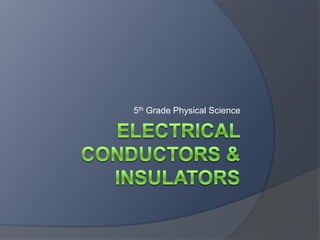
Electrical conductors & insulators
- 1. 5th Grade Physical Science
- 2. Recap In our previous lesson, we learned that: • Electricity is the movement of electrons from one atom to another. • Current electricity flows through conductors while static electricity collects on a surface. • Current electricity moves through circuits that are either series (no branches) or Source: http://www.bbc.co.uk/bitesize/ks3/science/energy_electricity_forces/electric_current_voltage/revision/4/ parallel (branches).
- 3. In this lesson you’ll learn how not every material allows electric current to flow through them in the same way. First, though, let’s review what electricity and electric current is: Electricity & Magnetism (stop when it gets to magnetism)
- 4. Conductors & Insulators Some materials allow electric charges to pass through them easily, these materials are called conductors. Other materials do not allow electric charges to pass through them easily, these materials are called insulators. (This is probably something you want to write down) Source: http://www.physics4kids.com/files/elec_conduct.html
- 5. Conductors & Insulators Below is a picture of a typical wire. Draw it in your notebooks and label which part is a conductor and which is an insulator. Why do you think they are arranged in this way?
- 6. Let’s Try It! Circuits & Conductors Click on the link (above), then follow the directions to use a circuit to test whether different objects are insulators or conductors. Electrical Conductors Click on the link (above), and follow the directions to discover what materials are conductors and which are insulators.
- 7. Now You Try It! Follow your teacher’s directions to construct a simple circuit and test your own materials to see if they are conductors or insulators.
Editor's Notes
- Click on link to review electricity, stop when you get to magnetism.
- Students record definition of conductors and insulators in notebooks.
- Students draw wire, label conductor and insulator, and explain why they are arranged with the insulator on the outside (safety)